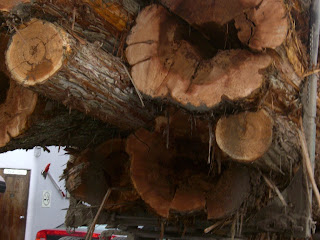

Found a couple of photos on the cutting room floor that were missed from the last post. These were taken on the beach at Kokanee Creek Provincial Park on the West Arm of Kootenay Lake.

The park is 19 km east of Nelson, and 15 Km west of Balfour. The park provided a welcome overnight stopover after a visit to Ainsworth Hot Springs further north.
I also took some photos of Columbia Lake near Canal Flats and some of the signs at the highway viewpoint. I was pleased to note that all the photos on the "Friends of the Columbia Wetlands" were credited to Hans Fuhrer, who I used to work with at Kootenay National Park.


It was dark when I reached Lussier Hot Springs, which is now within Whiteswan Lake Provincial Park, so I did not take any photos of the actual springs, but through the wonder of the modern internet, I am able to provide you of a daylight shot of where I sat enjoying the stars that night.

Lussier Hot Springs
On departure the next day, I took some photos along the access road. Portions of the road are not for the faint-hearted. Some sections are one-lane, with a serious vertical drop to the river below. Both logging trucks and some sort of rock trucks were using the road from about midnight on, making the one-lane cliff sections high on the pucker factor. The trucks all use two-way radios to avoid colliding with each other, but the tourists are at their mercy. I had my scanner going, so at least I knew where they were, if not vice versa. I only stopped on wide sections for these photos.

Logging road leading to Lussier Hot Springs and Whiteswan Lake Provincial Park.


On the way back through Sinclair canyon, near Radium Hot springs in Kootenay National Park, I snapped a shot of the mirror used to see around the corner in the canyon. If you click on the photo for a larger view, you should be able to see the camper in the mirror.

Highway mirror at Sinclair Canyon near Radium.
But prior to that, I parked in the village of Radium Hot Springs, where I knew there was a web cam in operation. So I got out of the truck and posed in front of it for the photo you see here.

Web cam shot of me and the camper in Radium Hot Springs village.
If you had been watching the web cam link above at the time, you would have seen me 'live'! Of course, I had the laptop in the truck and access to nearby wi-fi signal, so I was able to see this shot from the driver's seat while parked there. Pretty weird, huh? But it gets better.
Since I had wi-fi signal, and had been away from home for a few days, I decided to check my e-mail and have a look at my own web cam - which looks out my front window at home. If you've been reading this blog for a while, you will remember shots of deep snow banks and snowblowers from this cam - while I was on a Mexican beach camping for free. But I digress.
The web cam image is usually pretty static and mundane and boring. Imagine my surprise to see 3-4 people, ladders and gear sitting on my front sidewalk! Turns out they were there to clean my chimney. So, the next shot is a screen-shot from my laptop at the time, showing me in my truck in front of the Radium web cam, and my home cam on the other half of the screen - at the same time!

Screen shot of Radium and home web cam at the same time.

Web cam shot from home.
Till next time ...




































